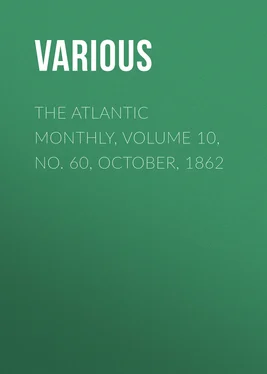Various - The Atlantic Monthly, Volume 10, No. 60, October, 1862
Здесь есть возможность читать онлайн «Various - The Atlantic Monthly, Volume 10, No. 60, October, 1862» — ознакомительный отрывок электронной книги совершенно бесплатно, а после прочтения отрывка купить полную версию. В некоторых случаях можно слушать аудио, скачать через торрент в формате fb2 и присутствует краткое содержание. Жанр: foreign_antique, periodic, foreign_edu, на английском языке. Описание произведения, (предисловие) а так же отзывы посетителей доступны на портале библиотеки ЛибКат.
- Название:The Atlantic Monthly, Volume 10, No. 60, October, 1862
- Автор:
- Жанр:
- Год:неизвестен
- ISBN:нет данных
- Рейтинг книги:3 / 5. Голосов: 1
-
Избранное:Добавить в избранное
- Отзывы:
-
Ваша оценка:
- 60
- 1
- 2
- 3
- 4
- 5
The Atlantic Monthly, Volume 10, No. 60, October, 1862: краткое содержание, описание и аннотация
Предлагаем к чтению аннотацию, описание, краткое содержание или предисловие (зависит от того, что написал сам автор книги «The Atlantic Monthly, Volume 10, No. 60, October, 1862»). Если вы не нашли необходимую информацию о книге — напишите в комментариях, мы постараемся отыскать её.
The Atlantic Monthly, Volume 10, No. 60, October, 1862 — читать онлайн ознакомительный отрывок
Ниже представлен текст книги, разбитый по страницам. Система сохранения места последней прочитанной страницы, позволяет с удобством читать онлайн бесплатно книгу «The Atlantic Monthly, Volume 10, No. 60, October, 1862», без необходимости каждый раз заново искать на чём Вы остановились. Поставьте закладку, и сможете в любой момент перейти на страницу, на которой закончили чтение.
Интервал:
Закладка:
No wonder that we must have our annual Cattle-Show, and Fall Training, and perhaps Cornwallis, our September Courts, and the like. Nature herself holds her annual fair in October, not only in the streets, but in every hollow and on every hill-side. When lately we looked into that Red-Maple swamp all a-blaze,—where the trees were clothed in their vestures of most dazzling tints, did it not suggest a thousand gypsies beneath,—a race capable of wild delight,—or even the fabled fawns, satyrs, and wood-nymphs come back to earth? Or was it only a congregation of wearied wood-choppers, or of proprietors come to inspect their lots, that we thought of? Or, earlier still, when we paddled on the river through that fine-grained September air, did there not appear to be something new going on under the sparkling surface of the stream, a shaking of props, at least, so that we made haste in order to be up in time? Did not the rows of yellowing Willows and Button-Bushes on each side seem like rows of booths, under which, perhaps, some fluviatile egg-pop equally yellow was effervescing? Did not all these suggest that man's spirits should rise as high as Nature's,—should hang out their flag, and the routine of his life be interrupted by an analogous expression of joy and hilarity?
No annual training or muster of soldiery, no celebration with its scarfs and banners, could import into the town a hundredth part of the annual splendor of our October. We have only to set the trees, or let them stand, and Nature will find the colored drapery,—flags of all her nations, some of whose private signals hardly the botanist can read,—while we walk under the triumphal arches of the Elms. Leave it to Nature to appoint the days, whether the same as in neighboring States or not, and let the clergy read her proclamations, if they can understand them. Behold what a brilliant drapery is her Woodbine flag! What public-spirited merchant, think you, has contributed this part of the show? There is no handsomer shingling and paint than this vine, at present covering a whole side of some houses. I do not believe that the Ivy never sear is comparable to it. No wonder it has been extensively introduced into London. Let us have a good many Maples and Hickories and Scarlet Oaks, then, I say. Blaze away! Shall that dirty roll of bunting in the gun-house be all the colors a village can display? A village is not complete, unless it have these trees to mark the season in it. They are important, like the town-clock. A village that has them not will not be found to work well. It has a screw loose, an essential part is wanting. Let us have Willows for spring, Elms for summer, Maples and Walnuts and Tupeloes for autumn, Evergreens for winter, and Oaks for all seasons. What is a gallery in a house to a gallery in the streets, which every market-man rides through, whether he will or not? Of course, there is not a picture-gallery in the country which would be worth so much to us as is the western view at sunset under the Elms of our main street. They are the frame to a picture which is daily painted behind them. An avenue of Elms as large as our largest and three miles long would seem to lead to some admirable place, though only C– were at the end of it.
A village needs these innocent stimulants of bright and cheering prospects to keep off melancholy and superstition. Show me two villages, one embowered in trees and blazing with all the glories of October, the other a merely trivial and treeless waste, or with only a single tree or two for suicides, and I shall be sure that in the latter will be found the most starved and bigoted religionists and the most desperate drinkers. Every wash-tub and milk-can and gravestone will be exposed. The inhabitants will disappear abruptly behind their barns and houses, like desert Arabs amid their rocks, and I shall look to see spears in their hands. They will be ready to accept the most barren and forlorn doctrine,—as that the world is speedily coming to an end, or has already got to it, or that they themselves are turned wrong side outward. They will perchance crack their dry joints at one another and call it a spiritual communication.
But to confine ourselves to the Maples. What if we were to take half as much pains in protecting them as we do in setting them out,—not stupidly tie our horses to our dahlia-stems?
What meant the fathers by establishing this perfectly living institution before the church,—this institution which needs no repairing nor repainting, which is continually enlarged and repaired by its growth? Surely they
"Wrought in a sad sincerity;
Themselves from God they could not free;
They planted better than they knew;—
The conscious trees to beauty grew."
Verily these Maples are cheap preachers, permanently settled, which preach their half-century, and century, ay, and century-and-a-half sermons, with constantly increasing unction and influence, ministering to many generations of men; and the least we can do is to supply them with suitable colleagues as they grow infirm.
THE SCARLET OAK
Belonging to a genus which is remarkable for the beautiful form of its leaves, I suspect that some Scarlet-Oak leaves surpass those of all other Oaks in the rich and wild beauty of their outlines. I judge from an acquaintance with twelve species, and from drawings which I have seen of many others.
Stand under this tree and see how finely its leaves are cut against the sky,—as it were, only a few sharp points extending from a midrib. They look like double, treble, or quadruple crosses. They are far more ethereal than the less deeply scolloped Oak-leaves. They have so little leafy terra firma that they appear melting away in the light, and scarcely obstruct our view. The leaves of very young plants are, like those of full-grown Oaks of other species, more entire, simple, and lumpish in their outlines; but these, raised high on old trees, have solved the leafy problem. Lifted higher and higher, and sublimated more and more, putting off some earthiness and cultivating more intimacy with the light each year, they have at length the least possible amount of earthy matter, and the greatest spread and grasp of skyey influences. There they dance, arm in arm with the light,—tripping it on fantastic points, fit partners in those aërial halls. So intimately mingled are they with it, that, what with their slenderness and their glossy surfaces, you can hardly tell at last what in the dance is leaf and what is light. And when no zephyr stirs, they are at most but a rich tracery to the forest-windows.
I am again struck with their beauty, when, a month later, they thickly strew the ground in the woods, piled one upon another under my feet. They are then brown above, but purple beneath. With their narrow lobes and their bold deep scollops reaching almost to the middle, they suggest that the material must be cheap, or else there has been a lavish expense in their creation, as if so much had been cut out. Or else they seem to us the remnants of the stuff out of which leaves have been cut with a die. Indeed, when they lie thus one upon another, they remind me of a pile of scrap-tin. 1 1 The original of the leaf copied on the next page was picked from such a pile.
Or bring one home, and study it closely at your leisure, by the fireside. It is a type, not from any Oxford font, not in the Basque nor the arrow-headed character, not found on the Rosetta Stone, but destined to be copied in sculpture one day, if they ever get to whittling stone here. What a wild and pleasing outline, a combination of graceful curves and angles! The eye rests with equal delight on what is not leaf and on what is leaf,—on the broad, free, open sinuses, and on the long, sharp, bristle-pointed lobes. A simple oval outline would include it all, if you connected the points of the leaf; but how much richer is it than that, with its half-dozen deep scollops, in which the eye and thought of the beholder are embayed! If I were a drawing-master, I would set my pupils to copying these leaves, that they might learn to draw firmly and gracefully.
Читать дальшеИнтервал:
Закладка:
Похожие книги на «The Atlantic Monthly, Volume 10, No. 60, October, 1862»
Представляем Вашему вниманию похожие книги на «The Atlantic Monthly, Volume 10, No. 60, October, 1862» списком для выбора. Мы отобрали схожую по названию и смыслу литературу в надежде предоставить читателям больше вариантов отыскать новые, интересные, ещё непрочитанные произведения.
Обсуждение, отзывы о книге «The Atlantic Monthly, Volume 10, No. 60, October, 1862» и просто собственные мнения читателей. Оставьте ваши комментарии, напишите, что Вы думаете о произведении, его смысле или главных героях. Укажите что конкретно понравилось, а что нет, и почему Вы так считаете.












